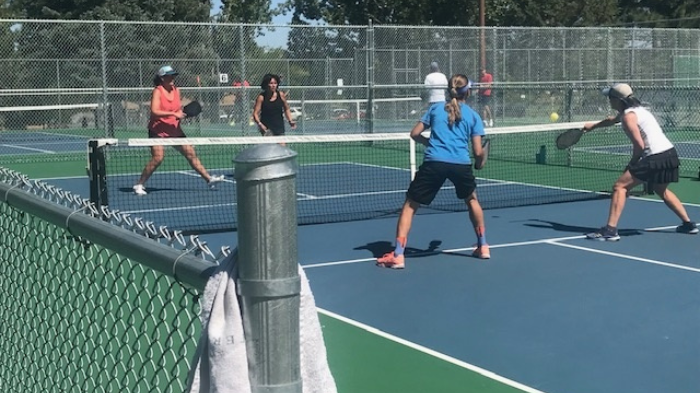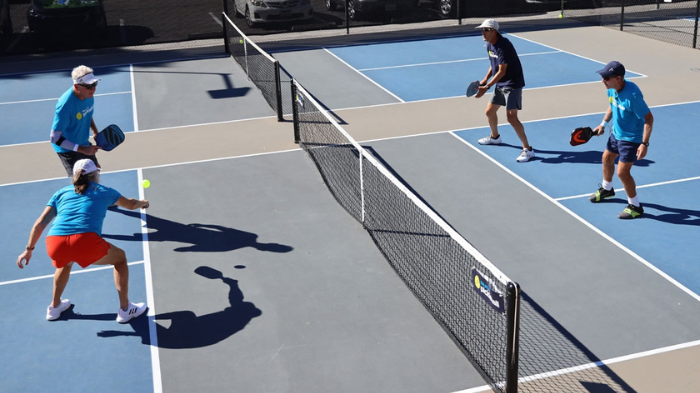Doubles pickleball is an exciting and fast-paced game that combines elements of tennis, badminton, and table tennis. Many pickleball lovers and players have the question, “How To Play Doubles Pickleball?”
Today, we are going to explain what is doubles pickleball, rules of pickleball doubles, and strategies on how to play doubles pickleball in this blog post. Read this blog, know the meaning of pickleball doubles and its rules, and utilize the pickleball doubles strategy for winning the game.

What Do You Mean by Doubles Pickleball?
In the context of pickleball, “doubles” refers to a form of gameplay where two teams, each consisting of two players, compete against each other. Doubles pickleball is played on a pickleball court, which is similar in size to a doubles badminton court.
The objective of doubles pickleball is to score points by hitting a perforated plastic ball (similar to a Wiffle ball) over the net and into the opposing team’s side of the court. The game follows specific rules, including serving diagonally, allowing only one serve attempt per turn, and the requirement for the receiving team to let the serve bounce before returning it.
In doubles pickleball, effective communication and coordination between teammates are vital. Players take turns hitting the ball and must cover their respective sides of the court. Strategies such as teamwork, positioning, and shot placement are crucial in gaining an advantage over the opposing team.
Doubles pickleball is a popular format as it encourages social interaction, teamwork, and fast-paced gameplay. It allows for more strategic play, as players can set up shots for their partner and capitalize on their strengths and skills.
Rules Designed for Doubles Pickleball
In doubles pickleball, two players form a team and compete against another pair of players. Here are some basic rules for pickleball doubles:
- Underhand Serves: All serves must be performed underhand, with the ball contacted below the waist.
- Diagonal Serves: Each serve must be made into the opposite diagonal service area. Failing to do so will result in a fault.
- One Serve Attempt: Players are allowed only one attempted serve.
- Initial Service Turn: At the start of the game, only one player from the serving team gets a service turn.
- Mandatory Court Movement: After scoring a point, the serving team’s member is required to switch to the opposite court’s end. This movement is compulsory.
- Non-Volley Zone (Kitchen): Players from both teams are not allowed to step into the non-volley zone or the kitchen while volleying. There are exceptions to the rule of not stepping into the non-volley zone or kitchen. These exceptions include when the ball bounces in the kitchen area or when hitting the ball from behind the non-volley zone.
- Double Bounce Rule: After the serve and return of serve, players must hit the first stroke without letting the ball bounce. This rule requires a double bounce shot.
Scoring and announcing the score in doubles pickleball adhere to the following rules:
- Winning The Game: The game continues until one team reaches 11 points and wins by a margin of at least two points.
- Scoring Points: Only the serving team can score points. The receiving team does not score if the serving team commits a fault.
- Calling Out The Score: The server must call out the score before each serve. The score includes three numbers: the serving team’s score, the receiving team’s score, and the server number (1 or 2).

4. Server Number: The server number indicates which player on the serving team is serving. The player who started on the serving side at the beginning of the game will always be the server. The server number changes after each fault by the serving team.
These rules govern the gameplay and scoring process in doubles pickleball, ensuring fair and organized matches.
Strategies for Playing Doubles Pickleball
There are several strategies that can be employed to enhance your performance in doubles pickleball. Here are some common strategies:
Communication: Effective communication with your partner is crucial in doubles pickleball. It is important to constantly communicate with your partner, informing each other about your positioning, shot selection, and intentions on the court. Clear communication helps to avoid collisions and ensures coordinated play.
Court Coverage: Divide the court with your partner to ensure maximum coverage. Each player should be responsible for their respective side of the court, anticipating shots and covering open areas. By positioning yourselves strategically, you can reduce the opponent’s chances of hitting shots that are difficult to return.
Teamwork And Coordination: Work together as a team by setting up and executing cooperative shots. Employ strategies like the “third-shot drop” to maintain control and force your opponents into defensive positions. Coordinate your movements to cover the court effectively and capitalize on each other’s strengths.
Shot Placement: To gain an advantage in the game, it is crucial to choose your shots strategically. Aim for open areas on the court and exploit your opponent’s weaknesses. Utilize different angles and place the ball precisely to keep your opponents constantly on their toes. This strategic approach will create valuable opportunities for successful shots, ultimately influencing the game’s outcome in your favor.
Volleys And Dinking: By becoming skilled in volleys and dinking, which are gentle shots played near the net, you can greatly improve your game and increase your likelihood of winning in doubles pickleball. Volleys exert pressure on the opponents and allow you to control the game’s pace. On the other hand, dinking enables you to engage in short, controlled rallies and strategically force errors from your opponents.
Non-Volley Zone Awareness: Be mindful of the non-volley zone (kitchen) and your positioning close to it. Avoid volleying from within the kitchen unless the ball has bounced there first. Strive to maintain good positioning around the kitchen to stay balanced and ready for quick reactions.
Adaptability: Adjust your gameplay according to the opponent’s strengths and weaknesses. Observe their patterns and tendencies, and adapt your strategy accordingly. Stay flexible and be prepared to make quick changes in shot selection and positioning.
Practice And Consistency: Regular practice and consistent play with your partner are essential for developing effective strategies and improving your overall performance. Work on drills, practice specific shots, and refine your teamwork through regular training sessions.

By implementing these strategies and refining them through practice, you can enhance your performance in doubles pickleball and increase your chances of success on the court.
FAQs
The server is responsible for calling out the score before each serve. The score is announced with three numbers: the serving team’s score, the receiving team’s score, and the server number (1 or 2). For example, “5-3-2” indicates that the serving team has 5 points, the receiving team has 3 points, and the server is the second player on the serving team.
No, all serves and shots must be performed using an underhand swing, with the ball contacted below the waist. Overhand swings are not allowed.
Players have only one attempt to serve. If the first serve is a fault, the serving team loses their serve and the opposing team gets the chance to serve.
In doubles pickleball, the game concludes when one team accumulates 11 points. However, a team must also maintain a lead of at least two points to secure victory. If the score reaches a tie of 10-10, the game extends until one team gains a lead of at least two points. This rule ensures a fair and conclusive outcome in the game.
Yes, each team is typically allowed one timeout per game. Timeouts can be used for strategizing, regrouping, or taking a break.
Conclusion
Doubles pickleball is a variation of the popular paddle sport played with two teams of two players each. It involves hitting a plastic ball over a net, with players taking turns and utilizing teamwork, strategy, and coordination to score points.
By understanding the doubles pickleball rules and the strategies on how to play doubles pickleball, you can elevate your performance in pickleball doubles. After writing this blog, we hope you have understood the meaning of doubles pickleball, along with its rules and strategies, which will help you to win the game.



